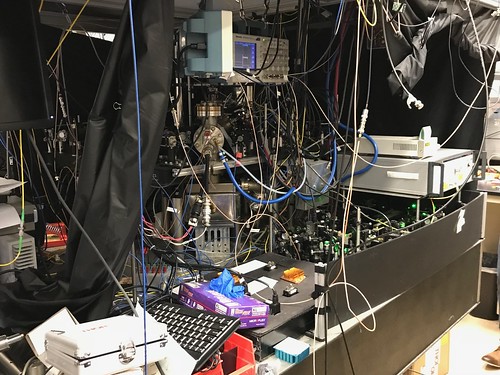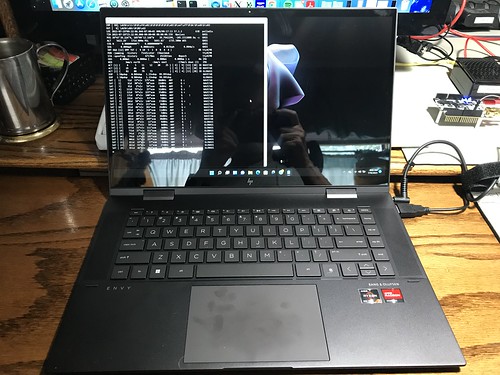(This blog article is a mash up of two long social media posts I made some time ago, so it might seem a little fragmented and repetitive, even though I've tried to edit it a little.)
The late H(oward) P(hillips) Lovecraft [1890-1937] is credited with inventing the genre of cosmic horror - one of my favorite genres in either print or visual media. I don't classify his iconic creation Cthulhu as comic horror. That gigantic octopus-headed other-worldly creature that lies dreaming deep under the sea in the impossibly ancient city of R'lyeh is way too anthropomorphic. Cthulhu is horrifying, sure, but cosmic horror is all about reality-bending stuff that comes from non-earthly realms and virtually defies description. Cosmic horrors aren't evil; they are indifferent, as uncaring about their impacts on us puny humans as a lawn mower is to ant hills. Cosmic horrors drive humans mad because of our inability to perceive and process their reality.

My affection for cosmic horror is one of the reasons my alter ego goes to science fiction conventions wearing pins or badges that identify him as a faculty member at Miskatonic University - that fictional university in an equally fictional Arkham County, Massachusetts situated on the banks of the still fictional Miskatonic River, where several Lovecraft stories take place.
(And in case you're wondering, there is absolutely no excuse for the terrible racism evident in some of H. P. Lovecraft's writing. In this respect he was wrong and ignorant, even for the time in which he lived and wrote, and that part of his work is repugnant and not to be admired. But I learned long ago that if I only love those who are perfect, I will come to love no one. So I celebrate his other work while decrying that part of his milieu.)
Cosmic horror is one of the reasons that, with some exceptions, I can't quite enjoy reading science fiction that casually features faster than light (FTL) travel or communication. (I'm just a little more forgiving of visual media in this respect, but not much.) My dilettante reading of physics leads me to interpret FTL as creating circumstances that would bend or break our very perception of reality, eliminating our ability to agree on basic cause and effect. It would lead to violations of the basic laws of physics - which is perhaps part of the definition of cosmic horror.
Here are some media - not intended in any way to be comprehensive - that I think fits the description of cosmic horror.
- John Carpenter's movie The Thing and John W. Campbell's novella "The Thing From Another World" on which it is based, is by far the best known example. (The Carpenter movie is also a great example of another horror genre, body horror).
- The movie Alien (but not so much the terrific sequel Aliens) shoots for a bit of cosmic horror, with an alien which could easily have been right out of Lovecraft's "Cthulhu Mythos", although it has the same anthropomorphic flaw as Cthulhu itself. [added 2023-06-19]
- The movie Event Horizon for sure has elements of "things man was not meant to know", all the result of the development of an FTL drive. [added 2023-06-19]
- Jeff VenderMeer's book Annihilation and the movie adaptation of the same name starting Natalie Portman was all about cosmic horror. (The book is part of a trilogy; I recommend the second and third books too.)
- The later books in James S. A. Corey's nine-novel series The Expanse are definitely cosmic horror. (The television adaptation didn't last long enough to really get to those parts.) The alien FTL technologies and nano-technology found by humans in the later parts of this epic series are not at all understood by the scientists, and they are appropriately horrified by their non-local behavior. (James S. A. Corey is the pen name of the authorial partnership of Daniel Abraham and Ty Franck.)
- And perhaps most controversially, even as most of it was based on the real science and technology of its day, I find Stanley Kubrick's movie 2001: A Space Odyssey to have elements of cosmic horror.
I’ve been thinking about this for some time now: The Expanse is obviously a great hard-SF saga of humans colonizing the solar system - and, eventually, beyond. Both the books and the television adaption are careful to obey the laws of physics, e.g. no FTL, no artificial gravity, and force, inertia, and momentum are all a bitch. But it’s not just that. In my opinion, it’s fused with a great story of cosmic horror, in the Lovecraft tradition, if H. P. Lovecraft had had some physics courses. (Lovecraft was in fact a great fan of astronomy in his time.)
I like to say that we really don’t want faster than light travel. When Einstein wrote
E = mc2
E was energy, m was mass, and c was… the speed of light in a vacuum? Not really.
The speed of light isn’t fixed. It has a top speed in a vacuum, but travels more slowly - indeed, sometimes more slowly than other particles - when going through a transparent medium. (That’s what causes the glow, called Cherenkov Radiation, in water-immersed reactors; particles that are the result of atoms fissioning travel through the water faster than photons, which in turn produces more photons.) But more weirdly: the speed of light is a particular medium is a constant for all observers in inertial reference frames (that is, moving but not accelerating), regardless of how fast each observer is moving relative to one another.
This is what special relativity is all about. If that weren't the case, stuff like the chemical reactions in our bodies that are necessary for life wouldn't work reliably. And keep in mind, we are all in motion, all of the time: we move on the surface of the Earth, the Earth orbits the Sun, the Sun travels through the Milky Way galaxy gravitationally dragging all of its planets along with it, the Milky Way moves through its local galactic cluster, the cluster... well, as far as we know, there's no end to it. All in motion, all of the time. There's no such thing as standing still. And if there were... standing still relative to what?
The variable c isn’t really the speed of light, in a vacuum or otherwise; it’s the speed of causality, the maximum speed at which cause-and-effect can travel. In a vacuum, light travels at this speed.
(Update: as far as I know, there is no definitive answer as to what Einstein and his peers had in mind when they chose c to stand for the speed of light in a vacuum; some have suggested it stands for constant.)
Special relativity is strange enough, in that observers, in different locations and traveling at different speeds in different directions, may legitimately disagree on the order of two independent events, “independent” meaning that those events are not connected directly or indirectly by cause and effect. There is no correct answer as to which event occurred first; it all depends on your point of view.
If we had faster than light travel, or faster than light communication, this gets even worse. Really, our basic perception of reality would come into question. We might not just disagree on the objective order of events, but information about events could arrive before the events apparently occurred. This is actually kinda scary.
Scary in a cosmic horror kind of way.

As I said before, while I’m a fan of H. P. Lovecraft - my alter ego has Miskatonic University business cards he uses for non-work related stuff - I find the popular conception of Lovecraft's creation Cthulhu to be way too anthropomorphic. The mere fact that we can describe Cthulhu - it (apparently) has an octopus head, a humanoid body, wings - means it's really not a cosmic horror. A true cosmic horror would be more of what Lovecraft meant when he wrote of people being driven insane because they could not possibly comprehend, much less describe, what they were witnessing and experiencing.

One of the things I liked about The Expanse books is that the scientists experimenting with the protomolecule and with the ring gates - both extraterrestrial technologies which humans manifestly did not understand any more than my cat understands my laptop - were actually deeply disturbed by the protomolecule's non-local behavior, and by the gates’ faster than light travel. And rightfully so. Lovecraft fans in The Expanse universe would have known that it would not end well. Technology that enables faster than light travel, and non-local behavior, is inevitably going to be a kind of cosmic horror, driving people mad with its non-Euclidian geometries.

So I have come to think of The Expanse series as a fusion of the hard-SF genre and the cosmic horror genre (with a little bit of body horror thrown in for good effect). I would not be surprised to find that the authors Daniel Abraham and Ty Franck had that in mind from the very beginning.














